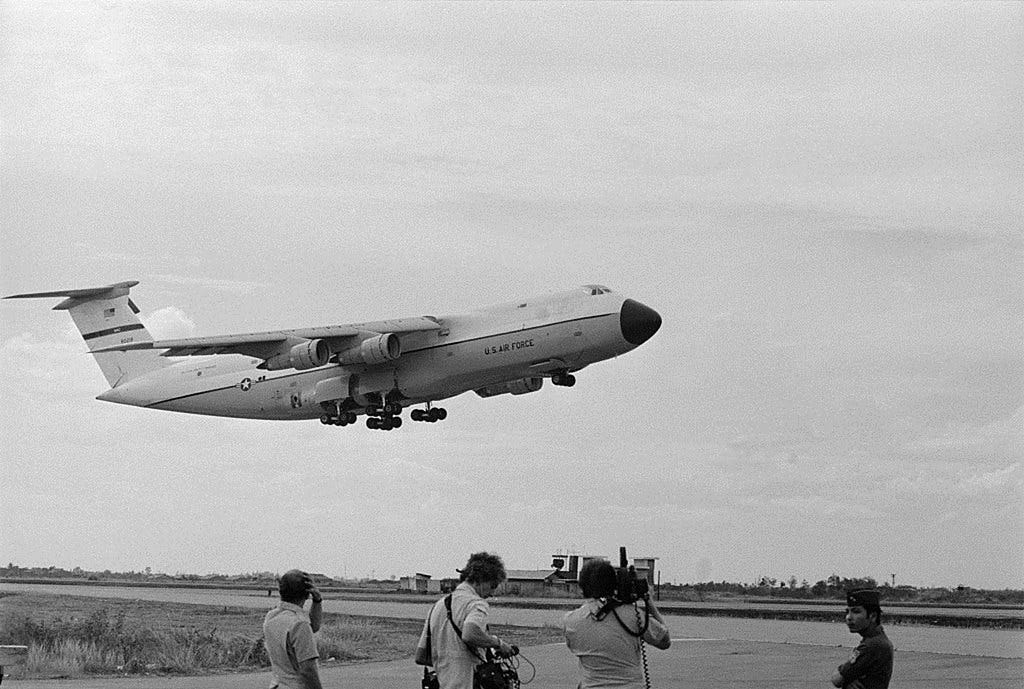A Lockheed Martin F-35B crashed at an Air Force base on Thursday in Fort Worth, Texas and the footage went viral. The 37-second video showed the plane hovering steadily over a runway before landing, bouncing, and the front wheel dislodging, which caused the plane to nosedive and spin counterclockwise. The pilot then ejected before suffering serious injury. This was just the latest in a series of crashes for the F-35—there were two other crashes earlier in the year, the most recent one in October at an Air Force base in Utah.
The footage went viral, I suspect, partly because of the confounding and absurd manner of the crash—the F-35 looked like a paper airplane tossing and spinning in the breeze, rather than a $100 million dollar plane. But also because the F-35 has become the objectification of the United States’ mismatched priorities, the bipartisan eagerness to fund tools of war rather than rebuild and expand affordable housing, address racial and economic inequality, provide maternity leave and child care for Americans, or do other things with federal dollars that could be considered socially productive. Seen from this perspective, the failures of the F-35 become a mirror to our own, to the United States’ perennial inability to look inward as opposed to outward to solve our problems. Innovations in warfare are demanded to satisfy our anxieties about “competition” with China, about the future of American primacy.
“We spent 1.7 trillion on this [F-35],” tweeted commentator Kyle Kulinski in response to the crash. Not quite. That 1.7 trillion figure is the projected cost of the F-35 over 66 years, so it is not real—yet. (Some not so fun, related facts: 1.7 trillion is also the amount of the spending bill that was approved by Congress to keep the government open next year, and the same amount of total federal student loan debt). But in some ways, the exorbitant cost of the F-35 downplays its impact on the future of American warfare.
The F-35 now has over a twenty-year history. After the Cold War, the Air Force looked to replace outdated F-16 fighter jets. After entertaining competing bids from Lockheed and Boeing, the Pentagon awarded Lockheed with the contract for a new fighter jet in 2001. The F-35 debuted in 2006. For over 15 years, F-35s have rolled off production lines to face a myriad of problems: the weight of the plane, its software, even its ability to maneuver properly. By 2015, after more than a decade of investment, when the plane was still projected to cost under a 1 trillion dollars, the F-16 still proved to be the superior plane.
Yet the problems that plagued the F-35 are historical; they are systemic across the defense industry. Indeed, the F-35 is not an anomaly. It is a feature, not a bug, of the defense acquisition process and the public-private relationships between the military, defense contractors, and Congress that trace their origins to the early Cold War.
When I read stories of the F-35’s malfunctions, its cost overruns to fix those issues, and the congressional hearings chastising (mildly or with sympathy) the Pentagon and defense company executives for the delays and outsized expenditures, I am reminded of the C-5A Galaxy plane. One of the major defense “boondoggles” of the Cold War era, the C5-A had a wingspan the size of a football field. It was not an advanced fighter jet like the F-35, but a transport plane meant to carry 200,000 pounds of cargo. Lockheed Martin received the contract for the C5-A in the early months of the Vietnam War in 1965, a $3 billion contract that ballooned into a 9-billion-dollar expense to the federal government by the early 1970s. The C5-A had cracks in its wings and ultimately became unable to fulfill its purpose: carry 200,000 pounds. It could manage only about half that amount. Lockheed spent millions more to fix the problems, but to no avail.
Because of its inefficiency and cost, the Air Force reduced its orders of the C5-A in 1970, leaving Lockheed in a bind. By 1971, the cost overruns to the C5-A, along with overruns for the L-1011 Tristar commercial airliner, brought Lockheed to the brink of bankruptcy. Private banks cutoff lending to Lockheed by the spring of 1971 and it looked like Lockheed was going under.
A C5-A Galaxy plane leaves South Vietnam, 1975
Only the federal government could save Lockheed. The company asked Congress for a bailout in loan guarantees totaling $250 million. If it did not get the monies, Lockheed would collapse and take “25,000 to 30,000 jobs” in 34 states along with it, not to mention its importance to U.S. national security interests. Lockheed gave Congress an ultimatum; it put a metaphorical gun to lawmakers’ heads. Democratic representative William Moorhead from Pennsylvania best summed up the situation: “This is like an 80-ton dinosaur who comes to your door and says, ‘if you don’t feed me I will die and what are you going to do with 80 tons of stinking dinosaur in your yard.’” Lockheed became one of the first companies “too big to fail,” as Bill Hartung suggested in his book, Prophets of War.
After a contentious and close debate in the Senate—one held at the zenith of public opposition to the Vietnam War—the loan guarantees passed. Congress did not want to lose its investment in the plane, and to cut jobs so close on the heels of a recession, and amid rising inflation rates. The C5-A continued operating in America’s wars, eventually getting retooled and improved to become the C5-B, then the C5-C. It now flies as the C5-M.
The Air Force is now rethinking its commitment to the F-35, whether to reduce its planned purchases of the plane. So is it possible that the F-35 will be the successor to the C5-A in the sense that its cost overruns will lead to insolvency (once again) for Lockheed, and will force scrutiny, if not a reevaluation of the military-industrial complex? Highly unlikely, I’m afraid.
Those interested in cutting and reforming the defense budget, in cancelling programs like the F-35—let alone demilitarizing America’s economy—face several hurdles. The most conspicuous is the jobs argument, the claim that ending the F-35 will send Americans to the unemployment line. Production of the C5-A plane impacted workers predominantly in a handful of states: Georgia, California, and Wisconsin. Parts for the F-35, however, are made in 45 states and Puerto Rico. This includes the various subcontractors making the F-35, leading to a grand total of almost 300,000 jobs. This is not a massive sum relative to the 163 million Americans in the workforce, but the scattering of jobs throughout the country deters even the most progressive legislators, like Independent Senator from Vermont Bernie Sanders, from stopping production of the F-35 in their states.
Sales of the F-35 to foreign countries are also essential to how the United States conducts its diplomatic affairs. The United States has authorized F-35 sales to countries like Poland and contemplated F-35 sales to Turkey to contain Russia’s influence. These sales—and the prospect of additional ones—have become more important to America’s foreign policy interests since the invasion of Ukraine in February. Moreover, the explosion of the global arms trade since the 1970s—a topic covered by historian Jonathan Ng—has made the F-35 a proxy of alliance building in an era of great-power competition.
Then there is the role that defense companies play in the larger political economy. Journalist Valerie Insinna, who has done some excellent reporting on the F-35 for Breaking Defense and Defense News, among other outlets, wrote a story on the F-35 back in 2019 for The New York Times that revealed how Lockheed Martin applied its private influence over the budgetary future of the F-35, how the contracting process granted purview to Lockheed to manage a government product. The foxes guarded the hen house. As Insinna wrote:
“One factor that kept sending the F-35 program off course was the level of control Lockheed exerted over the program. The company produces not only the F-35 itself but also the training gear for pilots and maintenance technicians, the aircraft’s logistics system and its support equipment, like carts and rigs. Lockheed also manages the supply chain and is responsible for much of the maintenance for the plane. This gave Lockheed significant power over almost every part of the F-35 enterprise. ‘I had a sense, after my first 90 days, that the government was not in charge of the program,’ said [Air Force lieutenant Christopher] Bogdan, who assumed oversight as the program’s executive officer in December 2012. It seemed ‘that all of the major decisions, whether they be technical, whether they be schedule, whether they be contractual, were really all being made by Lockheed Martin, and the program office was just kind of watching.’”
Lockheed’s F-35, unlike its C5-A, is produced in an era where the defense industry has become increasingly privatized since the 1970s. As historians Jennifer Mittelstadt and Mark Wilson argue in a recent essay in their edited volume, The Military and the Market, the privatization of the military in recent decades was “a political project…informed both by rigid ideological positions in favor of private enterprise and by self-interested searches for greater profits through takeovers of government resources and functions.”
Add to this the current foreign policy climate, where fears of a war with China send Americans into a panic, and F-35 fighter jets are relied upon as necessary tools to be deployed if and when the Chinese decide to invade Taiwan. Air Force leadership is also deferential to the F-35’s potential, rather than its current capabilities, believing that the flaws of the F-35 can be remedied in due time.
These factors combined are a recipe for the continued waste of federal resources, of taxpayers’ money. Or, for Lockheed, a recipe for great success. For while the F-35 is getting mocked online, Lockheed is laughing all the way to the bank. The central challenge we face then is how to exert democratic control over such an undemocratic structure. Let’s start by targeting the F-35.
Thanks so much for reading and subscribing! Please feel free to share the essay and let me know your thoughts. This will not just be a defense wonk newsletter, I promise. I’m working on a couple essays for January (on the history of the War on Terror, and on anti-war economists ), and look forward to sharing those soon. Take care!




One of the things that haunts me about the F-35 is the possibility that the hack of the Joint Strike Fighter program introduced still undiscovered vulnerabilities or revealed information that greatly decreases its effectiveness, which the U.S. would only discover in combat.
I suggest that you publish a list of retired 3-stars and 4-stars who have taken well-compensated positions with defense contractors and consultants to the defense establishment. In my experience, the retired lower-ranked officers who take jobs as defense industry project managers cannot help but deferring to their previous commanders.